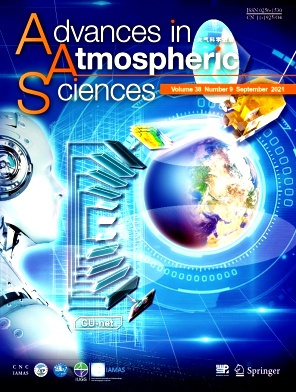
Advances in Atmospheric Sciences投稿地址
Advances in Atmospheric Sciences詳細信息
Advances in Atmospheric Sciences
Advances in Atmospheric Sciences
Advances in Atmospheric Sciences投稿要求
Advances in Atmospheric Sciences雜志投稿須知:
1、Manuscript componentsEach manuscript should include the following components, presented in the order shown.1) Title, name, affiliation of each author and corresponding author's email provided on the title page.2) Abstract. A brief, concise abstract is required at the beginning of each manuscript. The abstract contains a brief account of the background and rationale of the work, followed by a statement of the main conclusions. The abstract is typically 250 words or less in length and is unreferenced. The abstract should be 250 words or less in length. The abstract should not contain any mathematical expressions if possible, should include no footnotes or citations, and should not contain first-person sentence structure.3) Key words. 4-6 key words should be provided.4) Text. The text (12-point) should be typesetted in one column, divided into sections, each with a separate heading and numbered consecutively using following format1. Primary heading1.1 Secondary heading1.1.1 Tertiary heading1.1.1.1 Quaternary heading5) Acknowledgements. Keep this section as brief as possible by acknowledging only direct assistance in your research and writing. Financial support for the work done should be acknowledged here rather than as footnotes to the title.6) References. References should be arranged alphabetically without numbering. Citations to standard references in text should consist of the name of the author and the year of publication—for example, Wang (1990) or (Wang, 1990). If there are three or more authors, state the first author’s surname, followed by "et al." and the year of publication—for example, Wang et al. (1990) or (Wang et al., 1990). When there are two or more papers by the same author or authors in the same year, distinguishing letters (a, b, c, etc.) should be added to the year in both the citation in text and the reference listing, for example, Wang (1990a). For multiple citations by one author, separate years by commas, for example, Wang (1989, 1990) or (Wang, 1989, 1990). Separate multiple citations by different authors within the same parentheses by semicolons, for example, (Wang, 1990; Li, 1991) or (Wang, 1989, 1990; Li, 1991).7) Figure captions. Each figure must be supplied with a self-explanatory caption and all captions should be listed together. Authors should also include captions below the figures for the reviewer copies.8) Illustrations and tables. Each figure and table should be numbered consecutively and cited specifically in the text by number. All tables should have a title or legend.。
2、FormulasBrief equations or terms set inline in text must be set as a single line expression, if possible. Also please enter them directly from the keyboard if possible. For more complex variables that have both subscripts and superscripts, or have a more complicated operator such as a radical sign, use of the MathType equation editor is recommended.。
3、ReferencesReferences should be given alphabetically without numbering at the end of the paper. References must be complete and properly formatted and only literature cited in the text can be listed.1、 For typical journal citations it follows the form:Author(s), publication year: Article title. Journal name, volume, page range.For example,Boville, B. A., and J. W. Hurrell, 1998: A comparison of the atmospheric circulations simulated by the CCM3 and CSM1. J. Climate, 11, 1327–1341.2、 For a book it follows the form:Author(s), publication year: Book Title. Publisher, total pages.For example,Pedlosky, J., 1987: Geophysical Fluid Dynamics. 2nd ed., Springer-Verlag, 710pp.3、 For a chapter in a book it follows the form:Author(s), publication year: chapter title. Book Title, Editor(s), Publisher, page range.For example,Zhang, R. H., and J. P. Chao, 1993: Mechanisms of interannual variations in a simple air-sea coupled model in the tropics. Climate Variability, D. H. Ye, et al., Eds., China Meteorological Press, Beijing, 236–244.。
4、 For a website, it follows the form: Chou, M.-D., and M. J. Suarez, 1994: An efficient thermal infrared radiation parameterization for use in general circulation model. NASA Tech. Memo. 104606, Vol. 3, 85 pp. [Available online at NASA/Goddard Space Flight Center, Code 913, Greenbelt, MD 20771.]4、FiguresVector-based figures (eps., ai., or psd.) should be provided upon acceptance of a paper.。
5、AnimationAAS accepts submission with animation. Authors can submit it as supplementary materials via ScholarOne if the video is less than 10 M. The format flv. (or mpeg, avi, etc.) is desired. If the video is more than 10 M, authors are suggested providing a URL of the video for the convenience of the reviewers. The original video can be sent to the Editorial Office upon acceptance of the paper.。
6、Copyright informationAs a member of Committee on Publication Ethics (COPE), Advances in Atmospheric Sciences conforms to Code of Conducts and Guidelines of the Committee on Publication Ethics and is committed to publishing original work by the named author or authors.As soon as an article is submitted, authors will be requested to assign copyright of the article (or to grant exclusive publication and dissemination rights) to the publisher (respective the owner if other than Springer). This will ensure the widest possible protection and dissemination of information under copyright laws.
Advances in Atmospheric Sciences雜志簡介
《Advances in Atmospheric Sciences》雜志是由中華人民共和國新聞出版總署、正式批準公開發行的優秀期刊。
《Advances in Atmospheric Sciences》自創刊以來,以新觀點、新方法、新材料為主題,堅持"期期精彩、篇篇可讀"的理念。
《Advances in Atmospheric Sciences》內容詳實、觀點新穎、文章可讀性強、信息量大,眾多的欄目設置,Advances in Atmospheric Sciences公認譽為具有業內影響力的雜志之一。Advances in Atmospheric Sciences并獲中國優秀期刊獎,現中國期刊網數據庫全文收錄期刊。
《Advances in Atmospheric Sciences》現為國家自然科學基金委員會重點資助期刊,是大氣科學領域的學術性刊物,堅持“百花齊放,百家爭鳴”的方針,努力反映大氣科學領域的最新研究成果,及時刊登有創造性的學術論文及評述性文章,報道大氣科學領域內的新動向、新問題。國內外大氣科學領域著名科學家均向我刊投稿,編委由國內外大氣科學領域知名科學家共40多人組成。
Advances in Atmospheric Sciences統計分析
影響因子:指該期刊近兩年文獻的平均被引用率,即該期刊前兩年論文在評價當年每篇論文被引用的平均次數
被引半衰期:衡量期刊老化速度快慢的一種指標,指某一期刊論文在某年被引用的全部次數中,較新的一半被引論文刊載的時間跨度
他引率:期刊被他刊引用的次數占該刊總被引次數的比例用以測度某期刊學術交流的廣度、專業面的寬窄以及學科的交叉程度
引用半衰期:指某種期刊在某年中所引用的全部參考文獻中較新的一半是在最近多少年時段內刊載的
平均引文數:在給定的時間內,期刊篇均參考文獻量,用以測度期刊的平均引文水平,考察期刊吸收信息的能力以及科學交流程度的高低
熱門評論
投稿網真是物美價廉,價格實惠,包裝很精美,這本雜志里面的內容很實用,很精彩,對我具有極大的吸引力,而且還能從中收獲許多有益的知識,這是一本很不錯的雜志,值得推薦!
編輯部的人都很nice,效率很高,,審稿人的效率編輯部沒法控制了,但是編輯部會很積極的和審稿人進行溝通,有了消息會很快反饋給作者.總體來說Advances in Atmospheric Sciences雜志報也不是很難,效率很高的一個雜志,值得投稿!
審稿速度挺快的,2個月時間。我是3.24號投稿,5.25號錄用,中間經歷了大修和小修。兩個審稿人都很認真、負責,也是我們這個領域的專家,給了10多個修改意見。編輯部的老師們效率還是挺高的。
編輯的處理速度還是比較快的,初投之后第二天編輯便讓修改了一下格式返回,比較注重格式,只要內容符合雜志的方向,格式正確,編輯初審一般都可過。
速度真的很快,兩個審稿人,給的審稿意見中肯,一人只提了一些小問題,另一個提出說新意不夠及不應該用某種方法,總的來說對待審稿人的意見一定要認真對待,最好不要反駁。
訂的雜志,便宜,和郵局訂的感覺一樣,每期都收到,速度是沒話說的,書很好,文章都是那么優美,喜歡,包裝還可以,速度快,是正版,下次還要買。好書,推薦給朋友了,好評。
Advances in Atmospheric Sciences雜志審稿流程還是相對規范的。外審專家很認真,提了好多意見,編輯部速度很快,效率很高,總之這個雜志給人的感覺盡心盡責,很棒的雜志。
Advances in Atmospheric Sciences雜志速度挺快的,一般初審1-3天,待送外審5天,送審15天,然后出結果,如果不需要修改就直接錄用,修改的話還要耽誤15天,然后是交版面費,大約10天,總共一個半月搞定!
Advances in Atmospheric Sciences雜志審稿速度比較快,初審15天后進二審,再過15天后三審,三審當天顯示三審通過,今天收到了用稿通知,讓修改下格式發過去。很贊的期刊!
速度挺快,二十多天審稿,四個審稿人四個小修,修改后第二天接受。一般是三個以上審稿人,對創新性要求不高,但是內容要充實。。
相關問題
- Advances in Atmospheric Sciences是正規期刊嗎?
- Advances in Atmospheric Sciences是什么級別的期刊?是核心期刊嗎?
- Advances in Atmospheric Sciences評職稱可以嗎?單位認可嗎?
- Advances in Atmospheric Sciences是北大核心嗎?是中文核心嗎?
- Advances in Atmospheric Sciences是科技核心嗎?
- Advances in Atmospheric Sciences是統計源核心嗎?
- Advances in Atmospheric Sciences是南大核心CSSCI嗎?
- Advances in Atmospheric Sciences是CSCD期刊嗎?
- Advances in Atmospheric Sciences是國家級期刊嗎?
- Advances in Atmospheric Sciences是SCD期刊嗎?
- Advances in Atmospheric Sciences是國家新聞出版署第一批、第二批學術期刊嗎?
- Advances in Atmospheric Sciences好投嗎?Advances in Atmospheric Sciences簡介
相關期刊
更多常見問題
| Q:論文發表的時候可以一稿多投嗎? |
| A:一稿多投的行為是典型的學術不端的行為,是國內外學術界都明令禁止的行為,原因主要在于涉及到文章版權歸屬的問題,如果作者的文章已經被某個雜志社錄用,或者同時被兩家雜志社錄用,就會涉及到版權糾紛,作為雜志社都會保護本社的合法權益,到這時作者就會比較麻煩,吃官司都是小事兒了,被打入黑名單降級降職影響可就太大了。 |
| Q:職稱論文發表對時間有限制嗎? |
| A:職稱論文發表并沒有明確規定截止時間,需要作者結合自己所在地區的具體規定自己安排發表時間,一般職稱評審,各地區都會明確規定申報材料的最后期限和截止日期,我們結合這個日期來考慮何時發表文章就可以,大部分地區職稱評審都集中在每年的8-10月之間,有的地區要求7月中旬開始交材料,最晚8月底之前,有的則是要求8月中旬交,還有部分地區要求截止時間為申報時間上年的12月31日,所以,各個地區的具體要求并不同,申報者需要在提交材料前確保自己的文章已經見刊并且被相應的數據庫檢索即可。 |
| Q:網上發表論文如何防騙?可靠網站與可疑網站如何區分? |
| A:由于發表論文的需求遠遠多于雜志版面的供應,再加上眾所周知的審稿難!審稿慢!選擇論文發表網站發表表論文確實能解決以上問題。賣方市場的出現加之發表論文的剛性需求,就導致出現先付款后發表的現狀。論文發表網站正規與否是通過網站從始至終所提供服務體現出來的,任何交易只要存在時間差都會有風險,但這個風險是可以通過您的智慧來避免的。因為不是所有論文網站都是騙子,你要做的就是過濾掉沒保障的網站,選擇可靠的論文發表網站! |
| Q:一般期刊需要提前多久準備? |
| A:省級、國家級期刊建議至少提前6個月準備。一般來講,雜志社為了確保每期雜志正常出刊,都會提前將當期之后1-3個月的稿件提前安排好,而一些創刊較早,認可度更高的熱門期刊,來稿量較大,發表周期可能就會更久。提前準備,意味著雜志的可選擇性更多。 |
| Q:核心期刊需要提前多久準備? |
| A:核心期刊建議至少提前12個月準備,核心期刊正常的審稿周期為1-3個月,且審核嚴格,退稿、返修幾率更大,這意味著在流程上耗費的時間更久,且核心期刊版面有限,投稿競爭更加激烈,即使被錄用,排刊也比普通期刊晚很多,因此需要更早準備。 |






